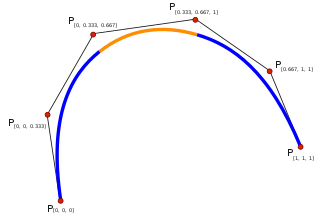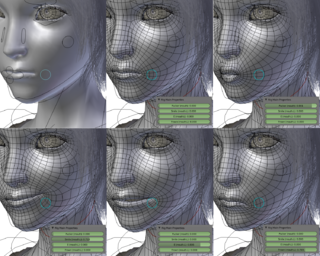
A Bézier curve is a parametric curve used in computer graphics and related fields. A set of discrete "control points" defines a smooth, continuous curve by means of a formula. Usually the curve is intended to approximate a real-world shape that otherwise has no mathematical representation or whose representation is unknown or too complicated. The Bézier curve is named after French engineer Pierre Bézier (1910–1999), who used it in the 1960s for designing curves for the bodywork of Renault cars. Other uses include the design of computer fonts and animation. Bézier curves can be combined to form a Bézier spline, or generalized to higher dimensions to form Bézier surfaces. The Bézier triangle is a special case of the latter.

Computer animation is the process used for digitally generating moving images. The more general term computer-generated imagery (CGI) encompasses both still images and moving images, while computer animation only refers to moving images. Modern computer animation usually uses 3D computer graphics.

In the mathematical field of numerical analysis, interpolation is a type of estimation, a method of constructing (finding) new data points based on the range of a discrete set of known data points.
In animation and filmmaking, a key frame is a drawing or shot that defines the starting and ending points of a smooth transition. These are called frames because their position in time is measured in frames on a strip of film or on a digital video editing timeline. A sequence of key frames defines which movement the viewer will see, whereas the position of the key frames on the film, video, or animation defines the timing of the movement. Because only two or three key frames over the span of a second do not create the illusion of movement, the remaining frames are filled with "inbetweens".

Motion compensation in computing is an algorithmic technique used to predict a frame in a video given the previous and/or future frames by accounting for motion of the camera and/or objects in the video. It is employed in the encoding of video data for video compression, for example in the generation of MPEG-2 files. Motion compensation describes a picture in terms of the transformation of a reference picture to the current picture. The reference picture may be previous in time or even from the future. When images can be accurately synthesized from previously transmitted/stored images, the compression efficiency can be improved.
Inbetweening, also known as tweening, is a process in animation that involves creating intermediate frames, called inbetweens, between two keyframes. The intended result is to create the illusion of movement by smoothly transitioning one image into another.

In vector computer graphics, CAD systems, and geographic information systems, geometric primitive is the simplest geometric shape that the system can handle. Sometimes the subroutines that draw the corresponding objects are called "geometric primitives" as well. The most "primitive" primitives are point and straight line segment, which were all that early vector graphics systems had.

Shading refers to the depiction of depth perception in 3D models or illustrations by varying the level of darkness. Shading tries to approximate local behavior of light on the object's surface and is not to be confused with techniques of adding shadows, such as shadow mapping or shadow volumes, which fall under global behavior of light.

Non-uniform rational basis spline (NURBS) is a mathematical model using basis splines (B-splines) that is commonly used in computer graphics for representing curves and surfaces. It offers great flexibility and precision for handling both analytic and modeled shapes. It is a type of curve modeling, as opposed to polygonal modeling or digital sculpting. NURBS curves are commonly used in computer-aided design (CAD), manufacturing (CAM), and engineering (CAE). They are part of numerous industry-wide standards, such as IGES, STEP, ACIS, and PHIGS. Tools for creating and editing NURBS surfaces are found in various 3D graphics, rendering, and animation software packages.

In mathematics, a spline is a function defined piecewise by polynomials. In interpolating problems, spline interpolation is often preferred to polynomial interpolation because it yields similar results, even when using low degree polynomials, while avoiding Runge's phenomenon for higher degrees.
In numerical analysis, a cubic Hermite spline or cubic Hermite interpolator is a spline where each piece is a third-degree polynomial specified in Hermite form, that is, by its values and first derivatives at the end points of the corresponding domain interval.
In the field of 3D computer graphics, a subdivision surface is a curved surface represented by the specification of a coarser polygon mesh and produced by a recursive algorithmic method. The curved surface, the underlying inner mesh, can be calculated from the coarse mesh, known as the control cage or outer mesh, as the functional limit of an iterative process of subdividing each polygonal face into smaller faces that better approximate the final underlying curved surface. Less commonly, a simple algorithm is used to add geometry to a mesh by subdividing the faces into smaller ones without changing the overall shape or volume.
An FCurve is a function curve or the graph of a function. An example of a FCurve is a spline.
Rotoshop is a proprietary graphics editing program created by Bob Sabiston.
Television standards conversion is the process of changing a television transmission or recording from one video system to another. Converting video between different numbers of lines, frame rates, and color models in video pictures is a complex technical problem. However, the international exchange of television programming makes standards conversion necessary so that video may be viewed in another nation with a differing standard. Typically video is fed into video standards converter which produces a copy according to a different video standard. One of the most common conversions is between the NTSC and PAL standards.

Motion interpolation or motion-compensated frame interpolation (MCFI) is a form of video processing in which intermediate film, video or animation frames are generated between existing ones by means of interpolation, in an attempt to make animation more fluid, to compensate for display motion blur, and for fake slow motion effects.

Morph target animation, per-vertex animation, shape interpolation, shape keys, or blend shapes is a method of 3D computer animation used together with techniques such as skeletal animation. In a morph target animation, a "deformed" version of a mesh is stored as a series of vertex positions. In each key frame of an animation, the vertices are then interpolated between these stored positions.
Animation departments are the teams within a film studio that work on various aspects of animation such as storyboarding or 3D modeling. It can refer to a single department that handles animation as a whole or to multiple departments that handle specific tasks. It can also refer to a college department.
This is a glossary of terms relating to computer graphics.
Motion interpolation is a programming technique in data-driven character animation that creates transitions between example motions and extrapolates new motions.









